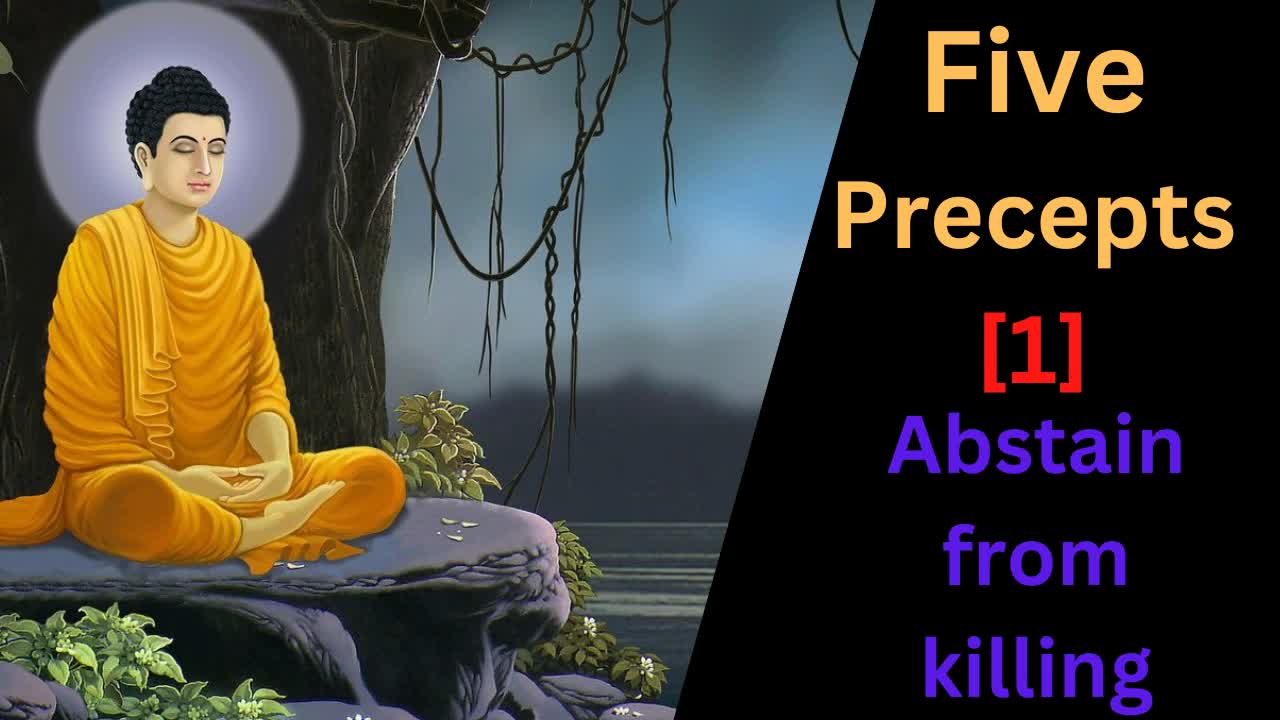Premium Only Content

Abstention from killing living beings | Budu Rajananvahanse | Universe True Story
taruwan saranai
First precept
1. Abstention from killing living beings
The first precept prohibits the taking of life of a sentient being. It is
violated when someone intentionally and successfully kills such a sentient being, having understood it to be sentient and using effort in the process.
Causing injury goes against the spirit of the precept, but does, technically speaking, not violate it.The first precept includes taking the lives of animals, even small insects. However, it has also been pointed out that the seriousness of taking life depends on the size, intelligence, benefits done and the spiritual attainments of that living being.
Killing a large animal is worse than killing a small animal (also because it costs more effort); killing a spiritually accomplished master is regarded as capital punishment. Suicide is also seen as part of the prohibition. Moreover, abortion (of a sentient being) goes against the precept, since in an act of abortion, the criteria for violation are all met. In Buddhism, human life is understood to start at conception.
A prohibition of abortion is mentioned explicitly in the monastic precepts, and several Buddhist tales warn of the harmful karmic consequences of abortion.
Bioethicist Damien Keown argues that Early Buddhist Texts do not allow for exceptions with regard to abortion, as they consist of a "consistent' (i.e. exceptionless) pro-life position". Keown further proposes that a middle way approach to the five precepts is logically hard to defend.
Asian studies scholar Giulio Agostini argues, however, that Buddhist commentators in India from the 4th century onward thought abortion did not break the precepts under certain circumstances.
Ordering another person to kill is also included in this precept, therefore requesting or administering euthanasia can be considered a violation of the precept,as well as advising another person to commit abortion.
With regard to euthanasia and assisted suicide, Keown quotes the Pali Digha Nikaya that says a person upholding the first precept "does not kill a living being, does not cause a living being to be killed, does not approve of the killing of a living being". Keown argues that in Buddhist ethics, regardless of motives, death can
never be the aim of one's actions.
Interpretations of how Buddhist texts regard warfare are varied, but in general Buddhist doctrine is considered to oppose all warfare. In many Jataka tales, such as that of Prince Temiya, as well as some historical documents, the virtue of non-violence is taken as an opposition to all war, both offensive and defensive. At the same time, though, the Buddha is often shown not to explicitly oppose war in his conversations with political figures.
Buddhologist André Bareau points out that the Buddha was reserved in his involvement of the details of administrative policy, and concentrated on the moral and spiritual development of his disciples instead. He may have believed such involvement to be futile, or detrimental to Buddhism.
Nevertheless, at least one disciple of the Buddha is mentioned in the texts who refrained from retaliating his enemies because of the Buddha, that is King Pasenadi (Sanskrit: Prasenajit).
The texts are ambiguous in explaining his motives though. In some later Mahayana texts,such as in the writings of Asa?ga, examples are mentioned of people who kill those who persecute Buddhists.
In these examples, killing is justified by the authors because protecting Buddhism was seen as more important than keeping the precepts. Another example that is often cited is that of King Du??hagama?i, who is mentioned in the post-canonical Pali Mahava?sa chronicle.
In the chronicle,the king is saddened with the loss of life after a war, but comforted by a Buddhist monk, who states that nearly everyone who was killed did not uphold the precepts anyway.
Buddhist studies scholar Lambert Schmithausen argues that in many of these cases Buddhist teachings like that of emptiness were misused to further an agenda of war or other violence.
Field studies in Cambodia and Burma have shown that many Buddhists considered the first precept the most important, or the most blamable.
In some traditional communities, such as in Kandal Province in pre-war Cambodia, as well as Burma in the 1980s, it was uncommon for Buddhists to slaughter animals, to the extent that meat had to be bought from non-Buddhists. In his field studies in Thailand
in the 1960s, Terwiel found that villagers did tend to kill insects, but were reluctant and self-conflicted with regard to killing larger animals. In Spiro's field studies, however, Burmese villagers were highly reluctant even to kill insects.
Early Buddhists did not adopt a vegetarian lifestyle. Indeed, in several Pāli texts vegetarianism is described as irrelevant in the spiritual purification of the mind.
There are prohibitions on certain types of meat, however, especially those which are condemned by society. The idea of abstaining from killing animal life has also led to a prohibition on professions that involve trade in flesh or living beings, but not to a full prohibition of all agriculture that involves cattle.
In modern times, referring to the law of supply and demand or other principles, some Theravādin Buddhists have attempted to promote vegetarianism as part of the five precepts. For example, the Thai Santi Asoke movement practices vegetarianism.
Furthermore, among some schools of Buddhism, there has been some debate with regard to a principle in the monastic discipline. This principle states that a Buddhist monk cannot accept meat if it comes from animals especially slaughtered for him.
Some teachers have interpreted this to mean that when the recipient has no knowledge on whether the animal has been killed for him, he cannot accept the food either.
Similarly, there has been debate as to whether laypeople should be vegetarian when adhering to the five precepts.Though vegetarianism among Theravādins is generally uncommon, it has been practiced much in East Asian countries,as some Mahāyāna texts, such as the Mahāparanirvana Sūtra and the Laṅkāvatāra Sūtra, condemn the eating of meat.
Nevertheless, even among Mahāyāna Buddhists and East Asian Buddhists there is disagreement on whether vegetarianism should be practiced.
In the Laṅkāvatāra Sūtra, biological, social and hygienic reasons are given for a vegetarian diet; however, historically, a major factor in the development of a vegetarian lifestyle among Mahāyāna communities may have been that Mahāyāna monastics cultivated their own crops for food, rather than living from alms.Already from the 4th century CE, Chinese writer Xi Chao understood the five precepts to include vegetarianism.
Apart from trade in flesh or living beings, there are also other professions considered undesirable.
Vietnamese teacher Thich Nhat Hanh gives a list of examples, such as working in the arms industry, the military, police, producing or selling poison or drugs such as alcohol and tobacco.
In general, the first precept has been interpreted by Buddhists as a call for non-violence and pacifism. But there have been some exceptions of people who did not interpret the first precept as an opposition to war.
For example, in the twentieth century, some Japanese Zen teachers wrote in support of violence in war, and some of them argued this should be seen as a means to uphold the first precept.
There is some debate and controversy surrounding the problem whether a person can commit suicide, such as self-immolation, to reduce other people's suffering in the long run, such as in protest to improve a political situation in a country.
Teachers like the Dalai Lama and Shengyan have rejected forms of protest like self-immolation, as well as other acts of self-harming or fasting as forms of protest.
Although capital punishment goes against the first precept, as of 2001, many countries in Asia still maintained the death penalty, including Sri Lanka, Thailand, China and Taiwan.
In some Buddhist countries, such as Sri Lanka and Thailand, capital punishment was applied during some periods, while during other periods no capital punishment was used at all.
In other countries with Buddhism, like China and Taiwan, Buddhism, or any religion for that matter, has had no influence in policy decisions of the government. Countries with Buddhism that have abolished capital punishment include Cambodia and Hong Kong.
In general, Buddhist traditions oppose abortion.In many countries with Buddhist traditions such as Thailand, Taiwan, Korea and Japan, however, abortion is a widespread practice, whether legal or not. Many people in these countries consider abortion immoral, but also think it should be less prohibited.
Ethicist Roy W. Perrett, following Ratanakul, argues that this field research data does not so much indicate hypocrisy, but rather points at a "Middle Way" in applying Buddhist doctrine to solve a moral dilemma.
Buddhists tend to take "both sides" on the pro-life–pro-choice debate, being against the taking of life of a fetus in principle, but also believing in compassion toward mothers.
Similar attitudes may explain the Japanese mizuko kuyō ceremony, a Buddhist memorial service for aborted children, which has led to a debate in Japanese society concerning abortion, and finally brought the Japanese to a consensus that abortion should not be taken lightly, though it should be legalized.
This position, held by Japanese Buddhists, takes the middle ground between the Japanese neo-Shinto "pro-life" position, and the liberationist, "pro-choice" arguments.Keown points out, however, that this compromise does not mean a Buddhist Middle Way between two extremes, but rather incorporates two opposite perspectives.
In Thailand, women who wish to have abortion usually do so in the early stages of pregnancy, because they believe the karmic consequences are less then. Having had abortion, Thai women usually make merits to compensate for the negative karma
taruwan saranai
-
 LIVE
LIVE
Trumpet Daily
29 minutes agoTrumpet Daily LIVE | Sept. 4, 2025
344 watching -
 1:01:50
1:01:50
VINCE
3 hours agoEpstein Victims Have Come Forth, The Names Have Not | Episode 118 - 09/04/25
140K85 -
 2:03:44
2:03:44
Badlands Media
7 hours agoBadlands Daily: September 4, 2025
35.1K3 -
 1:40:33
1:40:33
Dear America
3 hours agoEpstein Victims Vow To EXPOSE Everyone! + Are China and Russia Planning Against Trump?!
106K51 -
 LIVE
LIVE
Law&Crime
3 hours ago $2.12 earnedLIVE: Adelson Matriarch Murder Trial — FL v. Donna Adelson — Day 9
255 watching -
 LIVE
LIVE
The Big Mig™
2 hours agoCartels Are On Borrowed Time, Here Comes The BOOM!
5,082 watching -
 LIVE
LIVE
Matt Kohrs
13 hours agoMASSIVE Market Swings Incoming! || Top Futures & Options Trading Show
368 watching -
 2:59:29
2:59:29
Wendy Bell Radio
7 hours agoIt's All About the Benjamins
55.6K186 -
 LIVE
LIVE
JuicyJohns
3 hours ago $3.22 earned🟢#1 REBIRTH PLAYER 10.2+ KD🟢
70 watching -
 3:18:50
3:18:50
Times Now World
6 hours agoLIVE: NATO Chief Demands 5% of GDP for War Chest! Mark’s Bold Plan for Allies at IISS Prague Defence
28.1K13